Compiled by Walter Sorochan
Posted September 11, 2014; updated October 30, 2021. Disclaimer The information provided below is intended for educational purposes only. It is not meant to either directly or indirectly give medical advice or prescribe treatment.
Mushrooms = mycelium
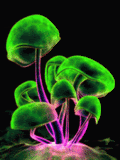
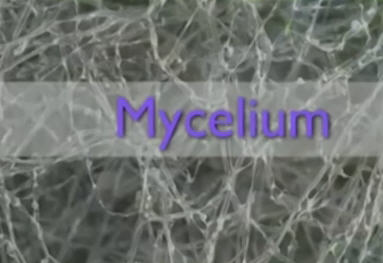 The two words mushroom and mycelium are related but different. A mushroom
is a fruit part of a fungus that consists of branching, thread-like hyphae,
referred to as Mycelium. These hyphae form colonies composed of mycelium found as mold on plants and food,
human infections as ringworm, jock itch, toe nail fungus and mostly in and on soil. Mycelium gives rise to a variety of fungi, molds, and mushrooms. We are probably
most familiar with mushrooms, for we eat them as a delicacy and as a medicine!
The two words mushroom and mycelium are related but different. A mushroom
is a fruit part of a fungus that consists of branching, thread-like hyphae,
referred to as Mycelium. These hyphae form colonies composed of mycelium found as mold on plants and food,
human infections as ringworm, jock itch, toe nail fungus and mostly in and on soil. Mycelium gives rise to a variety of fungi, molds, and mushrooms. We are probably
most familiar with mushrooms, for we eat them as a delicacy and as a medicine!
This article summarizes research since 1980 about both the mushrooms and its underground network of threadlike mycelium roots.
Our interest in mushrooms is basically four-fold: we eat them, we use mushrooms as a medicinal and our recent awareness of using mycelium as a pesticide/herbicide and as a purifier of the environment.
There are two kinds of mushrooms that one can can grow — decomposers and symbionts. The first kind, the decomposing fungi, are also called saprophytes, and they are the main type of mushroom considered for gourmet cultivation. These mushrooms include the oyster, lion's mane, hen-of-the-woods, shiitake mushrooms and also portobello, crimini, and button mushrooms, all of the same genus, Agaricus.
The second kind of fungi is symbiotic with plants, and like the nitrogen producing bacteria present in the roots of garden peas and clover, they are a common and important part of forest ecosystems. Their mycelial nets, being much finer than plant roots, are able to gather large amounts of water and trace minerals from the soil, which are shared with plant rootlets. For its part, the plant shares the some sugar it produces photosynthetically with the mycelium, and so both organisms benefit.
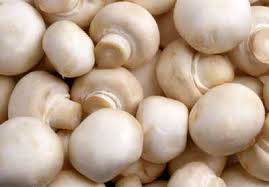 Mushrooms grow from
the mycelia and are the fruit or reproductive part of the mycelium network. About 90 % of the mushrooms eaten in USA and Canada are white button mushrooms [ photo on right ].
Mushrooms grow from
the mycelia and are the fruit or reproductive part of the mycelium network. About 90 % of the mushrooms eaten in USA and Canada are white button mushrooms [ photo on right ].
Even though the white button, crimini, and portabellas are the same species, they have different nutrition profiles. Although the nutrient value of the mushroom changes as it matures, mushroom in general are very nutritional and are an excellent source of protein. The nutritional value of mushrooms can be viewed at the end of this article.
List of a few sources of mushroom spawn [seed ] are available at end of this article.
Medicine-health enhancing mushrooms in photos below:
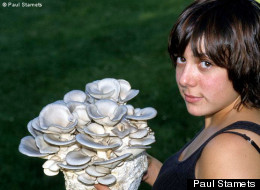 |
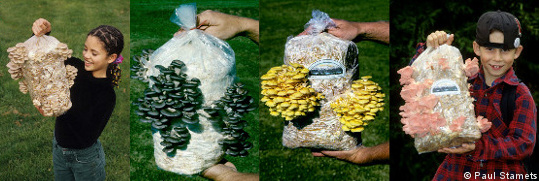 |
| Oyster | Pleurotus ostreatus, P. columbinus, P. citrinopileatus, P. djamor |
Oyster mushrooms are rich in protein (up to 30 percent by dry weight), plentiful in B vitamins, have no cholesterol, and have significant levels of the cholesterol-lowering molecule lovastatin -- up to 2.8 percent by dry weight [Stamets, 2005; Alarcon, 2003]. Stamets: Oyster mushroom & health 2013
ALERT: All mushrooms, with the exception of truffles, should be cooked to best take advantage of their beneficial nutritional properties while deactivating heat-sensitive toxins. Stamets: Oyster mushroom & health 2013 The agaricus genus contain a natural compound agaritine, that has been identified as a carcinogen. According to a study published in the journal Article in Food Additives and Contaminants is no longer active., cooking mushrooms by boiling, frying or microwaving reduces the amount of agaritine between 35 and 70 percent. [ While data using reasonable doses of mushrooms for short periods of time does not prove agaritine to be harmful, it still might be possible that agaritine-containing mushrooms have long-term toxic effects. More studies need to be conducted looking at long-term consumption at functionally relevant doses. ] Meanwhile, this alert information is just that, eating cooked mushrooms is considered to be safe.Paul Stamets: Turkey Tail mushrooms save cancer mom 3:56 mns long:
Source: Stamets: Stamets: no more breast cancer; Apr 28, 2013
Paul Stamets, mycologist, talks about the antimicrobial properties of fungi, how they can be used as potent insecticides, and how they may help boost the human immune system. Feb 23, 2012 Video Length 11:37 mns:
Source:
Stamets health from mushrooms 2012
Health benefits of mushrooms: Stamets: Oyster mushroom & health 2013 Collins: button mushroom benefits Fitzgerald: Mushrooms help immunity 2011 Grube: button mushrooms inhibit cancer 2001 USDA: Boost Immunity With Food and Sun 2010
Mushrooms and mycelia have complex sugars, polysaccharides, that the fungi produce to inhibit the growth of molds and bacteria in a mushroom. These sugars are linked to the medicinal and preventive health properties of mushrooms.
Amazing cancer cure case studies with maitake mushroom has been clinically proven to prevent and heal cancer, as well as decrease and even eliminate cancerous tumors. Collins: Maitake mushroom fights cancer Maitake has the ability to lower blood sugar because it naturally contains an alpha glucosidase inhibitor. Collins: Maitake mushroom fights cancer
Best cancer prevention mushrooms: Woodear, crimini, oyster, Italian brown, enoki, button, stuffing, shiitake, chanterelle, and Portobello mushrooms were compared to see which was best at inhibiting aromatase enzyme activity and prevent cancer.
Video best cancer prevention mushrooms Length 1:42 mns
Source: Best medicinal mushrooms
As of June 2014, whole mushrooms or mushroom ingredients were being studied in 32 human clinical trials registered with the US National Institutes of Health for their potential effects on a variety of diseases and normal physiological conditions, including vitamin D deficiency, cancer, bone metabolism, glaucoma, immune functions and inflammatory bowel disease. USNIH: research mushrooms 2014
Mycelium can save the world: The science goes like this: fine filaments of cells called mycelium, the fruit of which are mushrooms, already cover large areas of land around the world. As the mycelium grows, it breaks down plant and animal debris, recycling carbon, nitrogen, and other essential elements in the creation of rich new soil. This is the most important news for fixing burned out crop soils in the world. Article by Upton: Heterokaryosis hypothesis 2014 is no longer active. UDSA: Glomalin restores soil 2002
Stamets has also discovered that the enzymes and acids that mycelium produces to decompose debris are superb at breaking apart hydrocarbons — the base structure common to many plastics and pollutants. So, for instance, when diesel oil–contaminated soil is inoculated with strains of oyster mycelia, the soil loses its toxicity in just eight weeks. This ability of mycelium has been used to restore oil spills on land shores.
Mycelium facilitate fruit tree, lawn, crop and vegetable growth when grown in proximity to same. They make accessible nutrients not normally available to plants and transform woody material in soil or on the soil surface into rich hummus. Mycelium [fungus root] holds moisture in the soil and increases the soil food web's resistance to pathogens and imbalance: mycelium in your soil increases its resilience in the face of drought, flooding and pests. Article about Fungi Perfecti removing E Coli 2014 is no longer active. UDSA: Glomalin restores soil 2002
Recent research about mycelium: has new features.... low-tech, ecologically-friendly solutions to restoring earth:
1. regenerate dead soil into living humus soil; restores moisture in
soil, reduces soil acidity 2. has enzymes to decompose plant and animal debris: recycle oil
spills, garbage, recycle waste water, into essential reusable earth
chemicals 3. medical-health benefits: anti-inflammatory, anti-bacterial,
anti-viral, anti-tumoral 4. create natural pesticide to control / fight ants, termites 5. detoxifies nuclear radiation "mushroom mycelium is a rich resource of new antimicrobial compounds, which work in concert, helping protecting the mushrooms -- and us -- from microbial pathogens."
Stamets: Oyster mushroom & health 2013
Mushroom expert Paul Stamets explains how mushroom cultivation [mycelium] can
save the world in his book: MYCELIUM RUNNING. Reclaiming desert and wasteland Real Time: A real example of applying fungus to reclaim wasteland and save the world. Professor Alok Adholeya’s
laboratory at TERI University [ The Energy & Resources Institute ], is south from New Delhi, India. As a microbiologist he began in 1974 to reclaim
60 acres of wasteland in India .... that had been ruined by alkali-chlor sludge along the shorelines of Gujarat in the country’s west. The research and reclaimation project took over 20 years.
The surrounding extreme alkaline fields of dust [ pH 11 ] in this region [south of Delhi] are poisonous to most plants, hospitable only for patches of the most rugged and ragged of plant species. Adholeya used mycorrhizae [myco for short] – to reclaim waste land. Myco forms new mycorrhizal bonds between two kingdoms of life
--- plants and fungi. What makes that all the more extraordinary is the fact that fungi are more closely related to animals than they are to plants – both genetically and in the ways they lead their lives. Fungi inhale oxygen and exhale carbon dioxide, just like us. They have to eat to survive; they’re no better than we are at photosynthesizing.
Fungi live symbiotically with plants: fungi receive sugar as food in
exchange forgiving soil nutrients and water to plants. Adholeya began by introducing Myco-enriched plants into the harsh earth, planted in a succession of species. The first plants
planted were the hardiest ones, those that were the most tolerant to salty soil.
These included a fruitless variety of a tropical tree that normally produces purple berries known locally as jamun. Poplar trees also went in. By 1993, the team was planting the next wave of species – hardy acacias and bamboo. By
1996, the groundwater was fresh and the land looked much as it does today, vegetated from scratch in less than a decade by embracing the natural union between fungus and plants.
Beneath the grass and under the shadows of rose bushes and bottlebrush trees, myco
is invisibly working its magic. “There are trees and grasses there that are
self-sustained – they’re not watering them,” Adholeya said. “The rainfall is sufficient.” The soil beneath the TERI campus’s green canopies is still yellow and sandy to the touch, but it is healthy – deceptively rich in carbon and no longer severely alkaline. That’s because the myco fungi produced acids that brought the pH level below 8. The acids and enzymes reshaped nutrients in the soil, making them useful for plants. “So-called poor soils have an abundance of non-available nutrients,” Adholeya said. And the soils now contain
glomalin. Discovered by America’s agricultural department in the 1990s, globs of glomalin are carbon-rich hunks of soil produced by myco fungi.
UDSA: Glomalin restores soil 2002
They are used as glue to gum up soil around growing mycelia, creating passageways for nutrients and water. Glomalin permeates organic matter, binding it to silt, sand, and clay particles. Not only does glomalin contain 30 to 40 percent carbon, but it also forms clumps of soil granules called aggregates. These add structure to soil and keep other stored soil carbon from escaping. UDSA: Glomalin restores soil 2002 Adholeya has reclaimed the alkali wasteland with mycelium. Adholeya began rearing plants enriched with myco-infused roots in an onsite nursery.
More recently, TERI had signed an agreement MoU with IOCL on January 24, 2013 to implement a project titled 'Introducing the concept of Nutri-gardens to address rural malnutrition by involving KSKs (Kisan Seva Kendras)' in the tribal regions of Thane district, Maharashtra.
Forests & mycelium: Networks of mycorrhizal fungal mycelium have recently been discovered by Professor Suzanne Simard
and her graduate students, at the University of British Columbia Faculty of
Forestry, that connect to the roots of trees and facilitate the sharing of resources in Douglas-fir forests of interior British Columbia, thereby bolstering their resilience against disturbance or stress and facilitating the establishment of new regenerations.
Fungi can convert biomass into plant food: Not appreciated function
of fungi is its ability to convert biomass into compost. Composting can divert municipal solid waste from landfill
into compost, that in turn, can
restore humus into the soil. This means that fungial mycelium can make
unproductive soil become productive!
Fungi Perfecti removing E Coli 2014 Compost is an essential soil amendment and fertilizer for organic farming and gardening.
Article by Eirdosh: backyard grower is no longer active.
Researcher Paul Stamets points out that mycelium can be used to enrich burned
out farming soil as well as help purify waste water.
Fungi Perfecti removing E Coli 2014 There are many varieties of edible mushrooms. Since about 90 %
of the mushrooms eaten in USA and Canada are white button mushrooms, the
nutritive values of these mushrooms is displayed in the tables below: Nutritional Analysis of White Button Mushroom Explanation: Footnotes for Mushrooms, white, raw References: Armstrong W.P., "Amazing Trivia About Plants, Botanical Record-Breakers (Part 1 of 2)
January 26 2014. Article by Armstrong: Plant trivia is no longer active. Baker S. L., "White button mushrooms enhance the immune system to fight infections and cancer," Natural News, August 10, 2010.
Baker: button mushrooms enhance imunity 2010 "Clinical trials, "mushrooms" as search term". Clinicaltrials.gov. US National Institutes of Health, Clinical Trial Registry. June 2014. Retrieved 27 June 2014.
USNIH: research mushrooms 2014 Collins Danica, "Amazing Cancer Cure Case Studies with Maitake Mushroom,"
Collins: Maitake mushroom fights cancer
Collins Danica, "White Button Mushroom Health Benefits Have Been Uncovered," Underground health reporter.
Collins: button mushroom benefits
But the 900 million pounds of mushrooms Americans consume each year are mostly of the Agaricus bisporus variety, which includes regular white mushrooms (button, closed cup, open cup, and large flat) and brown mushrooms (also called chestnut, champignon marron, crimini, and portobello).
Eirdosh Dustin, "Farmers of Fungi - Growing Mushrooms and Mycorrhizae in Your Vegetable Patch," Homestead.
Article by Eirdosh: backyard grower is no longer active. Fitzgerald Patricia, "TEDMED: Can Mushrooms Help the Immune System Fight Cancer? Interview With Paul Stamets, Mycologist," The Huffington Post, November 02, 2011.
Fitzgerald: Mushrooms help immunity 2011 Fungi Perfecti, "FP's Mycofiltration Study Published in the Journal Ecological Engineering Date: July 01, /2014, 08:27; Posted by Fungi Perfecti Posted in: Mycotechnology
Fungi Perfecti removing E Coli 2014 Grube Baiba J, Elizabeth T. Eng, Yeh-Chih Kao, Annette Kwon, and Shiuan Chen, "White Button Mushroom Phytochemicals Inhibit Aromatase Activity and Breast Cancer Cell Proliferation1,2,"
J. Nutr. December 1, 2001, vol. 131 no. 12 3288-3293.
Grube: button mushrooms inhibit cancer 2001 Stamets Paul, "The Mighty Oyster Mushroom: The Workhorse of Gourmet Fungi," The Huffington Post, January 25, 2013.
Stamets: Oyster mushroom & health 2013 Stamets Paul, Mycelium Running - How Mushrooms Can Help Save The World, Book Upton John, "Fungi could help boost crops and slow global warming," Grist, January 14, 2014.
Upton: Fungi boost crops 2014 Upton John, "The Macro of myco," The Ascender Magazine, Issue 4 [Story Cover Photo: Mycelia by Laurel Fan]
Article by Upton: reclaiming deserts into fam land is no longer active. USDA, "Boost Immunity With Food and Sun," US Department of Agriculture, July 1, 2010.
USDA: Boost Immunity With Food and Sun 2010 USDA, "Glomalin: Hiding Place for a Third of the World's Stored Soil Carbon" Agricultural Research magazine,.September 2002.
UDSA: Glomalin restores soil 2002 Wikipedia, "Mycorrhiza." Wiki: plant mycelium link Wild Alissa, "Do Trees Communicate?" Wildness, July 14, 2014.
Wild: trees talk to each other 2014
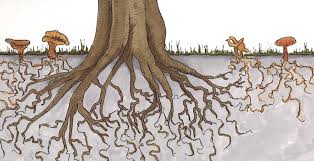 Mycelium
can grow underground into a small area [like a backyard garden compost bin] or
form a large forest colony or biomes hundreds of miles in size. Through the mycelium a fungus absorbs nutrients from its environment. It does this in a two-stage process. First, the hyphae secrete enzymes onto or into the food source, breaking down
the food into smaller units that can be absorbed into the mycelium [ breaking down leaves, old wood and debri into humus]. Secondly, since the mycelium colonies live symbiotically with the trees and vegetation,
the hyphae connect to the tree or plant roots, thereby providing the tree with food and water and in return, receive sugar from trees.
Mycelium
can grow underground into a small area [like a backyard garden compost bin] or
form a large forest colony or biomes hundreds of miles in size. Through the mycelium a fungus absorbs nutrients from its environment. It does this in a two-stage process. First, the hyphae secrete enzymes onto or into the food source, breaking down
the food into smaller units that can be absorbed into the mycelium [ breaking down leaves, old wood and debri into humus]. Secondly, since the mycelium colonies live symbiotically with the trees and vegetation,
the hyphae connect to the tree or plant roots, thereby providing the tree with food and water and in return, receive sugar from trees.
Nutrition Information
Cal Information: Amounts Per Selected Serving
unit per 1 cup, raw pieces or slices (70g)Calories 15.4 Cals
(64.5 kJ) From CHO 7.7 Cals
(32.2 kJ) From Fat 2.0
(8.4 kJ) From protein 5.7 (23.9 kJ) From Alcohol 0.0 0.0
Fats & Fatty Acids Fat Serv Amt %DV Total Fat 0.2 g 0% Saturated fat 0.0 g 0% Mono Sat Fat 0.0 g Polysaturated Fat 0.1 g Total trans fatty acids 0.0 0.0 Total trans-monoenoic fatty acids 0.0 0.0 Total trans-polyenoic fatty acids 0.0 0.0 Total Omega 3 fatty acids 0.0 0.0 Total Omega-6 fatty acids 97.3 mg 0.0
Protein & Amino Acids Amino Acid Serv Amt mg % DV Protein 2.2 g 4 % Tryptophan 24.5 mg 0.0 Threonine 74.9 0.0 Isoleucine 53.2 0.0 Leucine 84.0 0.0 Lysine 74.9 0.0 Methionine 21,7 0.0 Cystine 8.4 0.0 Phemyalanine 59.5 0.0 Tryosine 30.8 0.0 Valine 162 0.0 Arginine 54.6 0.0 Histidine 39.9 0.0 Alanine 139 0.0 Aspartic acid 137 0.0 Glutamic acid 240 0.0 Glycine 64.4 0.0 Proline 53.2 0.0 Serine 65.8 0.0 Hydroxyproline 0,0 0.0
Vitamins Vitamin Serv Amt mg % DV Vit A 0.0 IU 0 % Retinol 0.0 mcg Retinol activity Equiv 0.0 mcg Alpha carotene 0.0 mcg Beta carotene 0.0 mcg Beta cryptoxanthin 0.0 mcg Lycopene 0.0 mcg Lutein-Zeaxanthin 9.9 mcg Vit C 1.5 mcg 2 % Vit D 12.6 IU 3% Vit E Alpha Tocopherol 0.0 mcg 0% Beta Tocopherol 0.0 mg 0% Gamma Tocopherol 0.0 mg Delta Tocopherol 0.0 mg Vit K 0.0 mcg 0% Thiamin 0.1 mg 4% Riboflavin 0.3 mg 4% Niacin 2.5 mg 13% Vit B6 9.1 4% Folate 11.2 mcg 3% Food Folate 11.2 mcg Dietary Folate equivants 11.2 mcg Vit B12 0.0 mcg 9% Pantothenic Acid 1.0 mg 10% Choline 12.1 mg Betaine 6.6 mg
Minerals Mineral Serv Amt mg % DV Calcium 2.1 mg 0% Iron 0.3 2% Magnesium 6.3 2% Phosphorus 60.2 6% Potassium 223 6% Sodium 3.5 0% Zinc 0.4 2% Copper 0.2 11% Manganese 0.0 2% Selenium 6.5 mcg 9% Fluoride 6.5 mcg 9%
Carbohydrates
Serv Amt Total Carbohydrate 2.3 g Dietary Fiber 0.7 g Starch 0.0 g Sugars 1.2 g Sucrose 0.0 mg Glucose 1035 mg Fructose 119 mg Lactose 0.0 mg Maltose 0.0 mg Galactose 0.0 mg
Other
Other Serv Amt %DV
Alcohol 0.0 g
Water 64.7 g
Ash 0.6 g
Caffeine 0.0 g
Theobromine 0.0 g
Sterols Sterols Serv Amt %DV Cholesterol 0.0 mg 0% Phytosterols 0
Percent Daily Values (%DV) are for adults or children aged 4 or
older, and are based on a 2,000 calorie reference diet. Your
daily values may be higher or lower based on your individual
needs.
Nutrition Data's Opinion, Completeness Score™, Fullness Factor™,
Rating, Estimated Glycemic Load (eGL), and Better Choices
Substitutions™ are editorial opinions of NutritionData.com,
given without warranty, and are not intended to replace the
advice of a nutritionist or health-care professional. Nutrition
Data's opinions and ratings are based on weighted averages of
the nutrient densities of those nutrients for which the FDA has
established Daily Values, and do not consider other nutrients
that may be important to your health or take into account your
individual needs. Consequently, Nutrition Data's higher-rated
foods may not necessarily be healthier for you than lower-rated
ones. All foods, regardless of their rating, have the potential
to play an important role in your diet.
The Amino Acid Score has not been corrected for digestibility,
which could reduce its value.
For an analysis of Crimini mushroom go to Article about Crimini is no longer active.
"Amazing cancer cure case studies with maitake mushroom has been clinically proven to prevent and heal cancer, as well as decrease and even eliminate cancerous tumors. Maitake (grifola frondosa) is a polypore mushroom that is native to Japan. It grows in clusters at the base of trees, particularly oaks, and has been prized for its medicinal properties for centuries. It is commonly known as Hen of the Woods, Ram's Head and Sheep's Head, and its Japanese name, maitake, literally means "dancing mushroom," a term derived from Japanese folk medicine. Maitake is best known for its cancer-fighting properties. In 2009, a phase I/II human trial was conducted by Memorial Sloan-Kettering Cancer Center, and it showed that maitake extract stimulates the immune systems of breast cancer patients. The results of the study were published in the Journal of Cancer Research and Clinical Oncology. Other laboratory studies involving Maitake D-Fraction (MDF), a standardized form of maitake mushroom containing grifolan -- an important beta-glucan polysaccharide, show evidence of MDF's therapeutic value. It exhibits anti-cancer activity, has the ability to block the growth of cancer tumors and boost the immune function of mice with cancer. A study published in the Townsend Letter for Doctors and Patients, Feb/Mar 1996 involving 165 individuals with advanced cancer used MDF. This form of maitake was found effective against leukemia as well as stomach and bone cancers. A Japanese clinical study investigated the effectiveness of administering a combination of MDF and whole maitake powder on 36 cancer patients ranging in age from 22 to 57 years old, who were in stages II to IV. Cancer regression or significant symptom improvement was observed in 11 of 16 breast cancer patients (68.8%); 7 of 12 liver cancer patients (58.3%); and 5 of 8 lung cancer patients (62.5%). Here are just a few of the amazing case studies that show the immune-potential effects of maitake in cancer patients. Liver Tumor Disappears Completely A 47-year-old female presented with Stage II hepatocellular carcinoma (cancer of the liver). In March 1994, she was treated with the drug cisplatin 4 times daily. In January 1995, she began taking maitake MD-fraction and 4 grams of whole maitake tablets daily, and the cisplatin treatment was discontinued. As of June 1997, the production of Interleukin-2 (IL-2) in her body multiplied by 2.2 times because of maitake administration. IL-2 is instrumental in the body's natural response to microbial infection. By July 1999 the tumor had completely disappeared. Lung Tumor Vanishes and Doesn't Reappear A 41-year-old female with Stage 3 intraductal carcinoma (breast cancer) had tumors that measured 2.4 cm and 0.7 cm in diameter. In September 1996, she underwent surgery to have the tumors removed, and she began taking 10 mg of tamoxifen (TAM) and 100 mg 5-FU until December 1996. As of June 1997, the cancer metastasized, and a 1.3 cm tumor was found in a lung. She was then administered 125 mg MD-fraction and 4 grams whole maitake tablets daily for 20 months. In March 1999, it was confirmed that the lung tumor had disappeared. While taking maitake, IL-2 production and CD4+ cells (a type of white blood cell that is important in fighting infections) increased by 1.5 and 1.3 times, respectively. As of early 2002, the tumor had not reappeared. Stage III Cancer Turns to Stage I A 45-year-old female with Stage III liver cancer had a serum bilirubin of 3.2 mg/dL, albumin of 2.1 mg/dL, and prothrombin activation of 43 percent. In May 1995, she began receiving transcatheter arterial embolization (TAE) 10 mL lipiodol (iodized poppy seed oil), 15 mg ADM, and 100 mg cisplatin. That regimen was discontinued in January 1996 and was replaced by daily doses of 100 mg MD-fraction and 4 grams maitake tablets daily, along with 100 mg of the chemotherapy drug 5-fluorouracil (5-FU). Since February 1998 she has received only maitake products and is now diagnosed as Stage I. Source: Can Maitake MD-Fraction Aid Cancer Patients? - Noriko Kodama, PhD, Kiyoshi Komuta, MD, PhD, and Hiroaki Nanba, PhD Case histories such as those described above illustrate the immune-enhancing properties of MDF and whole powdered maitake. They also provide evidence that maitake has the potential to decrease the size of lung, breast and liver tumors. Although maitake mushroom is best known for its anti-tumor, cancer-fighting properties, it also has the following properties: Anti-Diabetic - People with Type 2 Diabetes have been found to benefit from maitake mushrooms. Maitake has the ability to lower blood sugar because it naturally contains an alpha glucosidase inhibitor. A specific, high-molecular polysaccharide called the X-fraction appears to be the active compound with anti-diabetic properties. Anti-Hepatitis - In clinical trials with 32 chronic hepatitis B patients, there was a 72% recovery rate in the group that was administered maitake, as compared to 57% in the control group. Anti-Hyperlipid - Many doctors in Japan use maitake mushrooms to: 1) lower serum and liver lipids (such as cholesterol, triglycerides, and phospholipids); and 2) regulate blood pressure -- two key risk factors in heart disease. Maitake mushrooms are eaten raw or cooked. Many people consume maitake as dietary supplements in the form of capsules and extracts called Maitake D-Fraction."
Researchers at Fungi Perfecti, LLC and Washington State University recently completed a pilot study to determine how
fungal mycelium can best be used to improve E. coli treatment in stormwater management. This mycofiltration biotechnology—the
use of intentionally cultivated networks of fungal mycelium to facilitate water quality improvements in engineered ecosystems—has
been a labor of love for Fungi Perfecti since Stamets invented the technique in the late 1980s. After receiving an EPA
Small Business Innovative Research grant to develop the approach in 2012, the ‘proof-of-concept’ R&D demonstrated that
statistically significant improvements in E. coli removal could be achieved using this low-cost, low-tech, and environmentally
rational approach. The results are published this month in the journal Ecological Engineering.
"Mycorrhizal fungi are critical for more varieties of crops than are bees — nine out of 10 crops have roots that are encrusted with these fungal tentacles. The fungi rummage through soil, fetching water and nutrients and delivering them to the roots of crops and other plants, receiving carbon-rich sugars produced through photosynthesis in return. The fungi protect the plants, which they are basically farming for sugar, from diseases and drought."
"A healthy myco layer doesn’t just help the soil – it helps the planet. When plants and their myco partners colonized land, they drew carbon dioxide out of the air and deposited it into the expanding soil. Carbon that used to be in the air was drawn into the Earth’s crust. As much as a quarter of the carbon in the world’s soil is now estimated to be in the form of glomalin. Research published in Science in March found that between 50 and 70 percent of the carbon stored in a Swedish forest was held not in the trunks and leaves, but in the soil – the so-called rhizosphere around the plants’ roots. The destruction of forests and the tilling of soil is releasing carbon from glomalin back into the air, where it’s contributing to global warming. Myco fungi are the only organisms capable of producing the glomalin needed to draw it back into the earth."
" myco is helping farmers and gardeners boost their harvests. Myco-loaded products that can be added to a vegetable patch or a furrow at planting time
can be found in most garden and hardware stores or ordered online."
"Could Iraqis farm the desert? There’s no reason why not. Similar efforts are already underway in Abu Dhabi, Kuwait and Oman."
"The soil beneath the TERI campus’s green canopies is still yellow and sandy to the touch, but it is healthy – deceptively rich in carbon and no longer severely alkaline. That’s because the myco fungi produced acids that brought the pH level below 8. The acids and enzymes reshaped nutrients in the soil, making them useful for plants. “So-called poor soils have an abundance of non-available nutrients,” Adholeya said. And the soils now contain glomalin. Discovered by America’s agricultural department in the 1990s, globs of glomalin are carbon-rich hunks of soil produced by myco fungi. They are used as glue to gum up soil around growing mycelia, creating passageways for nutrients and water. An experienced gardener can gauge the quality of soil by rubbing it between their fingers, judging its tilth. It is glomalin that causes soil to clump up in delightful aggregates, and it is glomalin that gives healthy soil its wonderfully tilthy quality."